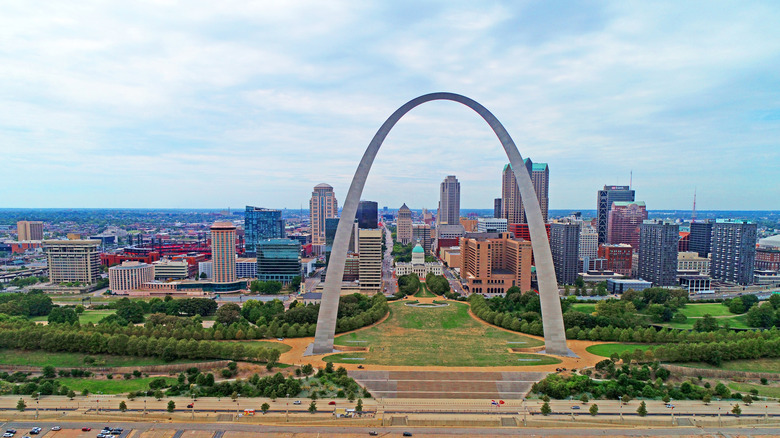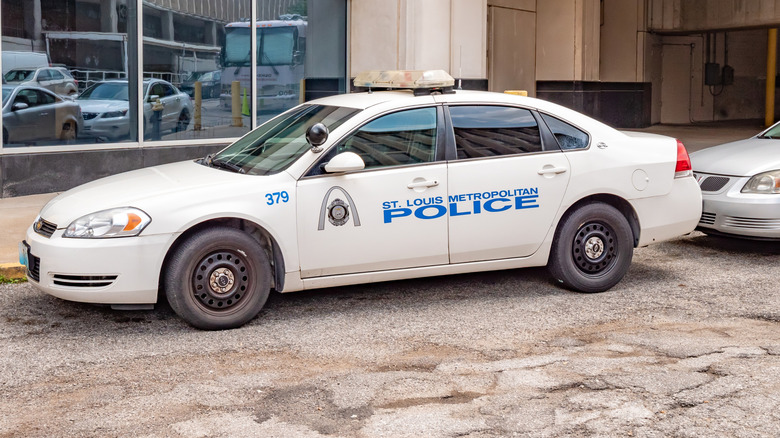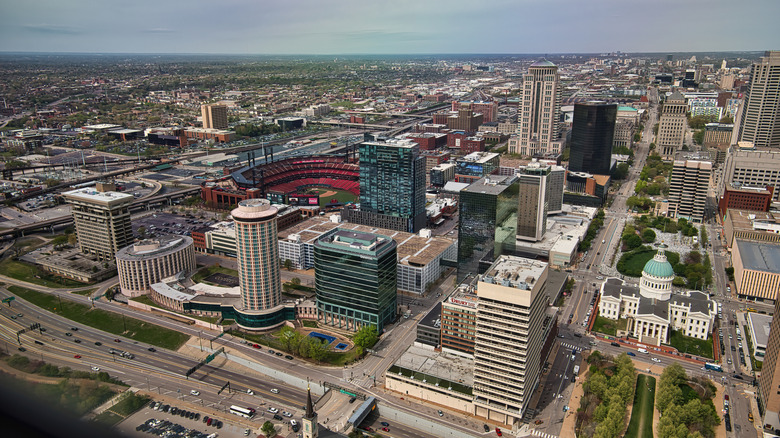Tourists Should Avoid This Dangerous Neighborhood When Visiting St. Louis
St. Louis, the celebrated "Gateway to the West," is steeped in Americana. It's the Midwestern headquarters of Anheuser-Busch and proud home to both the world-famous Gateway Arch and the St. Louis Cardinals, the second-winningest team in Major League Baseball history with 11 World Series wins. Unfortunately, the city's glory can often be overshadowed by its notorious crime rates. St. Louis topped BBC Science Focus Magazine's 2024 list of America's Most Dangerous Cities. Not all of St. Louis is dangerous, but tourists should definitely avoid one of its most crime-ridden pockets at all costs. Crime rates in the Peabody-Darst-Webbe neighborhood are an astonishing 438% higher than the national average and nearly 250% higher than the entire city.
Peabody-Darst-Webbe is located west of the Mississippi River, a mere five-minute drive from the Gateway Arch. The neighborhood ranks No. 2 on the 10 Most Dangerous Neighborhoods in America list on Money Inc., which was compiled using FBI data, local police department statistics, and community information. According to the site, the neighborhood's violent crime rates are about 3,500 per 100,000 people, and property crime rates weigh in at 9,000 per 100,000 people. In starker terms, these numbers reflect that one in eight residents will be a victim of crime.
Even worse, Peabody-Darst-Webbe's grim reputation has gone global. The neighborhood showed up on online magazine Grunge's 2023 list of The Most Dangerous Neighborhoods in the World, a dishonor it shared with several famously perilous places. Kingstown in Jamaica, a gang-infested Caribbean destination the U.S. government cautions against visiting, was on the list, as well as the Scampia neighborhood of Naples, a drug-dealing hot spot run by the vicious Camorra crime ring.
Why Peabody-Darst-Webbe is so dangerous
Small and densely packed, the Peabody-Darst-Webbe neighborhood is home to the Clinton-Peabody development, the oldest public housing project in St. Louis. The 24-acre development comprising 358 units scattered across 31 buildings was originally built in 1942 to house families in poverty, along with defense plant workers during the Second World War. Over time, socio-economic issues, a lack of resources, and limited healthcare in the historically low-income neighborhood have all contributed to its decline.
Along with this, the community of just over 2,000 residents faces a remarkably high 10.7% unemployment rate. While the neighborhood's median household income of $50,979 is higher than the national average of $45,140, it's not enough to lift the community out of poverty. Poor education is another outsized challenge. On the school ranking platform Great Schools, Peabody Elementary School has a C- rating, which fares slightly better than the D+ given to Vashon High School.
It's well known that several of these factorswhen combined, can create a perfect breeding ground for crime. It's hardly surprising, then, that violence thrives in Peabody-Darst-Webbe. Multiple, heartbreaking reports of shootings over the years, including in 2017, when a bullet fatally struck a ten-year-old boy in the Clinton-Peabody complex. Another incident involving a child occurred in 2022. At the neighborhood BP gas station, police have answered so many calls over the years for everything from fighting and stealing to homicides and assaults that they've since removed the telephones and ATMs. They're now considering whether to revoke the gas station's business license altogether.
Can marching for peace and revitalization efforts will help curb crime?
In July 2024, residents and community leaders fed up with the neighborhood's incessant violence came together to take to the streets for a peace walk. The community event was co-sponsored by the Office of Violence Prevention, the St. Louis Housing Authority, and the Violence Prevention Commission to promote a sense of community and non-violent conflict resolution. "The more we can have events like this and have kids know there are people working hard to provide a safe space for them that it maybe pulls them away from people who are intent on committing violent acts," Wilford Pinkney Jr., the Director of the Office of Violence Prevention, told St. Louis's First Alert 4 News. Neighborhood residents already have more peace walks planned for the future.
Currently, Peabody-Darst-Webbe is undergoing a massive $150 million revitalization project. In 2023, residents of the Clinton-Peabody apartments voted to tear down the dilapidated, 80-year-old development. The plan is to replace it with 350 new affordable housing residences comprising multi-family apartments and townhomes. The project also includes a neighborhood facelift with a remodeled community center, an updated street grid, and a one-and-a-half-acre community park featuring family-friendly sports fields, playgrounds, pathways, and even a splash pad.
Time will tell if this significant overhaul and the peace walks will inspire a downward trend in neighborhood crime. In the meantime, skip Peabody-Darst-Webbe in favor of exploring vibrant, safe neighborhoods like Clayton, a bustling, walkable suburb known as St. Louis's "second downtown."


